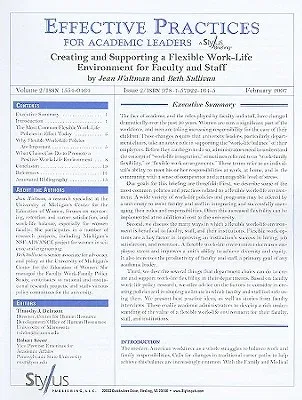**Executive Summary
The face of academe, and the roles played by faculty and staff, have
changed dramatically over the past 30 years. Women are now a significant
part of the workforce, and men are taking increasing responsibility for
the care of their children. These changes require that university
leaders, particularly department chairs, take an active role in
supporting the "work-life balance" of their employees. Before they can
begin to do so, administrators need to understand the concept of
"work-life integration," sometimes referred to as "work-family
flexibility," or "flexible work arrangements." These terms refer to an
individual's ability to meet his or her responsibilities at work, at
home, and in the community with a sense of competence and a manageable
level of stress.
Our goals for this briefing are threefold: First, we describe some of
the most common policies and practices related to a flexible work-life
environment. A wide variety of work-life policies and programs may be
offered by a university to assist faculty and staff in integrating and
successfully managing their roles and responsibilities. Often this
increased flexibility can be implemented at no additional cost to the
university.
Second, we discuss the many ways in which a flexible work-life
environment is beneficial to faculty, staff, and their institutions.
Flexible work options are a key factor in improving an institution's
success in hiring, job satisfaction, and retention. A flexible work-life
environment decreases employee stress and improves a unit's ability to
achieve diversity and equity. It also increases the productivity of
faculty and staff, a primary goal of any academic leader.
Third, we describe several things that department chairs can do to
create and support work-life flexibility in their departments. Based on
faculty work-life policy research, we offer advice on the factors to
consider in creating policies and in shaping a climate in which faculty
and staff feel safe using them. We present best practice ideas, as well
as stories from faculty interviews. These enable academic administrators
to develop a rich understanding of the value of a flexible work-life
environment for their faculty, staff, and institutions.
**

